A big welcome, especially if you’ve recently subscribed. This post has lots of images so it may be slow to load.
It's softly quiet in Tallinn. Three weeks ago I was panicking about finding a pair of boots with the three Ws. Warm, wide and waterproof, able to withstand walking on the layers of compacted ice that reveal themselves after the first flurry of snow. And yes, as predicted, snow is falling on the cobbles. I crunch past the sea of Valentine's Day red roses in the flower market, and try to ignore the McDonalds as I walk into the UNESCO heritage old town. I'm here two days ahead of my friends. Two days to explore, get my bearings, find the markets. Two years ago I was in Riga and Vilnius, and I'm expecting similar styles of food. Good dark rye bread as standard. A love affair with smoked and dried fish. An understanding of what's in season. Everything sea buckthorn. Coinciding with our visit, it's Tallinn bun festival. Similar to the Swedish semlor, these semi sweet yeasted buns, filled with cream, or variants are all over Tallinn in selected bakeries, in the lead up to Lent.
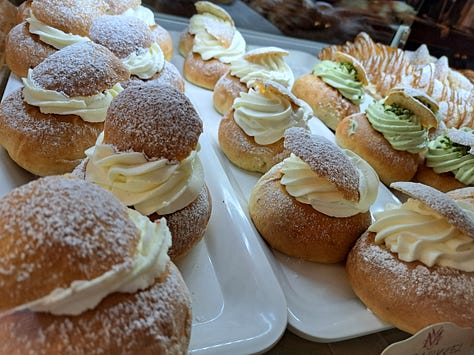
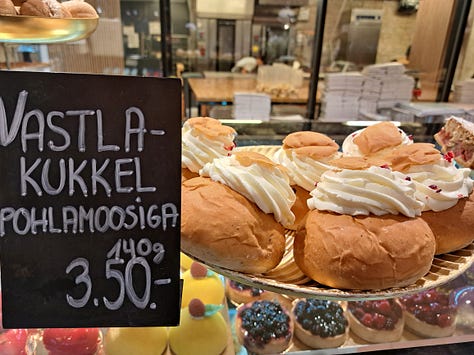
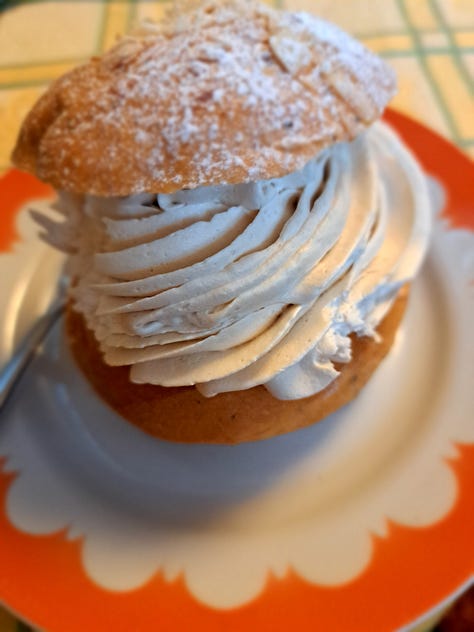
Tallinn is a small city on the edges of the Baltic sea. It's within waving distance of Helsinki, a mere two hours away by ferry. Three languages are spoken and understood. Estonian, Russian and English. There are Russian, Georgian, Ukrainian, Scandinavian influences, especially in the food. Music, especially folk music is important. So is bread. And saunas.
Time for a quick history lesson. If history isn’t your thing, feel free to scroll down a few paragraphs but I’ve included it for the context, because it’s what makes Estonia. Today is Estonian Independence Day, celebrated with enthusiasm and fervor. It's a young country. Estonia has been dominated by other nations for most of its existence. In the 1200’s, Estonia was invaded by German mercenaries from the south, Danes from the north, Swedes from the west, and Slavs from the east.
Estonian rule passed from Germans and Danes to Swedes and Poles, and finally to the Russians in 1721.
Baltic Germans in positions of wealth and power kept native Estonians as serfs. German was the official language of the Tallinn government until 1889.
Livonia: Northern Latvia and Southern Estonia, part of Poland, fought over in the 1500s by Russia, won and ruled over by Sweden in the North of Estonia and Poland in the south, until 1917.
Russia won Estonia and Livonia, making it part of the Russian empire from 1710. After the Russian revolution in 1917, Estonia and Livonia were unified and became one nation.
To understand the history of Estonia, pay a visit to the House of Peter the Great, the oldest museum in Tallinn, which has a succinct exhibition about the history of Tallinn. Close by in the beautiful park are the Kadriou palace and the Estonian Art Museum.
Cross town to the Museum of Occupation and Freedom, a thought provoking walk through the turbulent times from the 1930s when citizens were deported to concentration camps by the Nazis, and to Siberia by the Soviets. During the first Soviet occupation (from June 1940 to July 1941) thousands of people were repressed in Estonia, many political leaders, members of the cultural and economic elite were arrested, some were executed and the disappearance and imprisonment of people was organised on a mass scale. Estonian men were forcefully mobilised into the Red Army. More than 10,000 people were forcefully sent to Siberia from Estonia.
The German occupation lasted from the autumn of 1941 until the autumn of 1944. The Jewish community of Estonia was destroyed, and Estonians who resisted the occupying powers were imprisoned or killed.
In 1943, Coastal Swedes began to flee with the help of Swedish authorities, and nearly 70,000-80,000 people left Estonia. The museum has the only remaining boat used by people fleeing the country. The Soviet Union asked Sweden to send back its Estonian refugees. Sweden refused. They instead sent back the boats used in the crossing.
The Soviets controlled every aspect of daily life. Russian was the official language, lives were lived in fear. As the Museum says; Occupation, resistance, freedom and recovery.
Walking around the old town it's difficult to believe that it was heavily bombed by both the Soviet Air Force and the Luftwaffe during the 2nd world war.
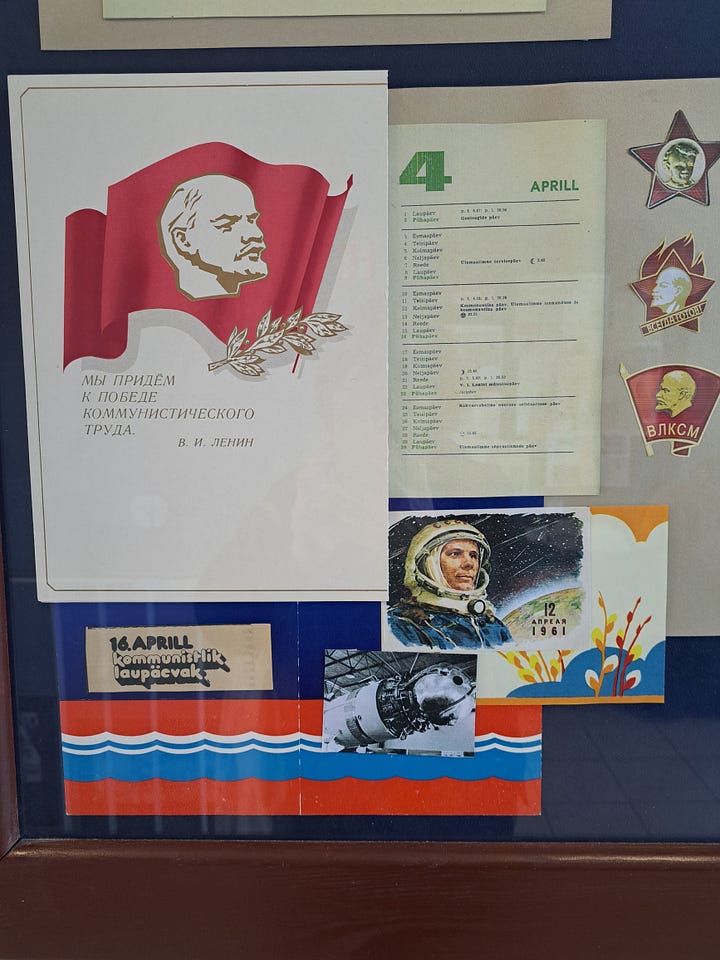
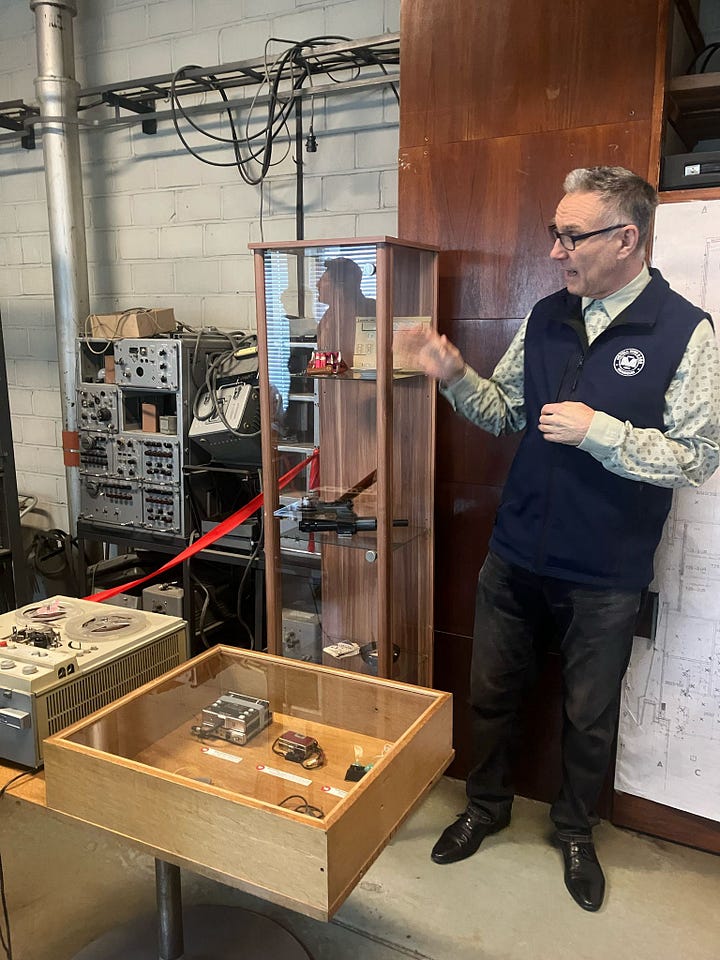
Estonia only emerged from the shadows of the Soviet regime in the 1980s. Visit the KGB museum at the Viru hotel, where your guide will tell you what it was like living in Soviet times; no beach visits allowed, tasting chewing gum for the first time, or the thrill of watching adverts from elicit Finnish television, showing products the average Estonian could only dream of. The entire hotel was full of microphones for spying on guests, which gave way to a local joke that Viru Hotel was built from a Soviet wonder material called micro concrete, consisting of 60 percent microphones and 40 percent concrete.
In 1988 the Singing Revolution led to songs being sung in the Estonian language in public again. Estonia finally declared its independence in 1991. The last Russian forces left in 1994. How can you not love a country that used music to free itself from the Soviet Union.
Russian is still the largest minority language in Estonia. Look at any Estonian website; frequently three languages will be available. Estonian, English and Russian. We passed the dark and silent Russian embassy every day on our way home. There's a constant police presence, and the street outside is covered with barriers loaded down with protest signs, candles, photos and Ukrainian flags.
Estonia, the Baltic Tiger, where Skype was invented. The country has been at the forefront of the tech revolution in Europe.
Out of the cobbled walled old town, Telliskivi is the hipster, street-art-clad sub-neighbourhood of Kalamaja that’s dubbed the “Creative City” of Tallinn. Fotografiska is based there, so are numerous craft breweries, coffee shops, art galleries, small businesses and restaurants. Quiet in winter, we could imagine how crowded it must get in the summer months. Good coffee, good bread.
Balti Jaama Turg (BJT) market is housed in old tram sheds next to Tallinn’s main train station (Balti Jaam). It’s open every day of the week and easy to spot and access. Bright, clean and welcoming, to one side, a row of huts hosting sellers of various food stuffs and cafes. Being winter, I didn’t spot any farm stands. On the other side, an indoor fish market. There’s a supermarket and shops on the lower ground.
On the ground floor, inside the market building, meat stalls, cheese, smoked meats, eggs, cakes, and in the centre, the largest stall, Eugenio’s, focused on Italian produce. A row of hot food stalls Tänavatoit. Continue through to find fruit and vegetable stands. Shops selling leib; bread. Very good bread, at the heart of Estonian culture. There’s a saying that in case a piece of bread is dropped, it should be picked up and given a kiss in order to show respect for it.
Dairy. Deli. An organic store. Stands selling honey. Oils. Spanish and Italian products. Pickles, ferments, seeds, nuts, herb teas. It's busy here. There are queues at the meat counters. Local people shopping. Up on the first floor you'll find clothing, antiques, souvenirs, Estonian crafts, cafes and micro-breweries.

Most of the hot food stalls are offering food I'm not interested in. Pizza, burgers, sushi, kebabs. There are plenty of takers but I know what I'm after. I'm still recovering from a 3.30 am start the previous day and I've had no breakfast. I find Pelmen, selling borscht and dumplings. It's perfect. I'm sorry I didn't take any pictures of the bread. Dark rye bread with seeds for our breakfasts from Muhu. There’s more. A woman selling a vast array of fascinating looking sweets. Huge bags of sunflower and pumpkin seeds. Pickled cucumbers and barrels of sauerkraut.


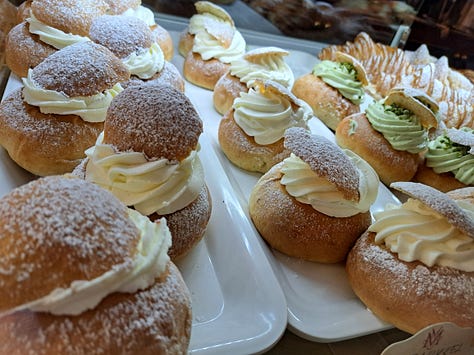

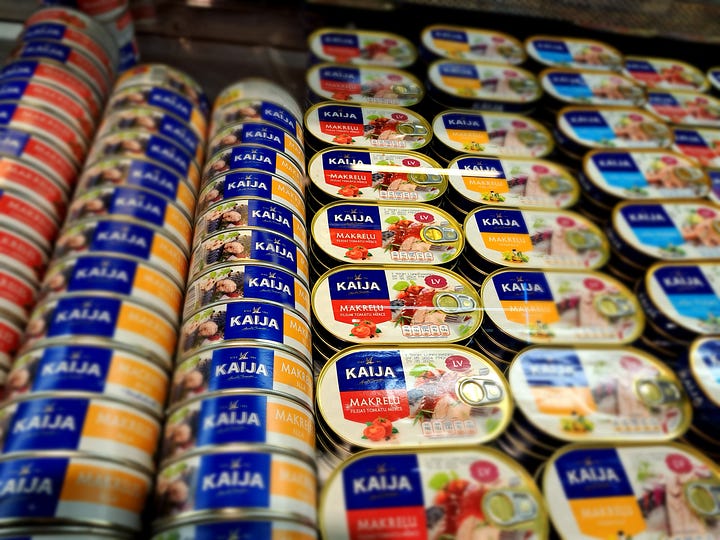
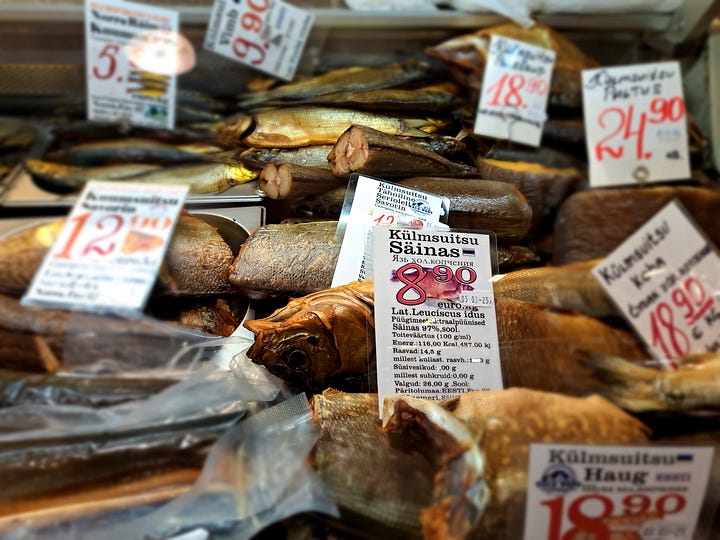
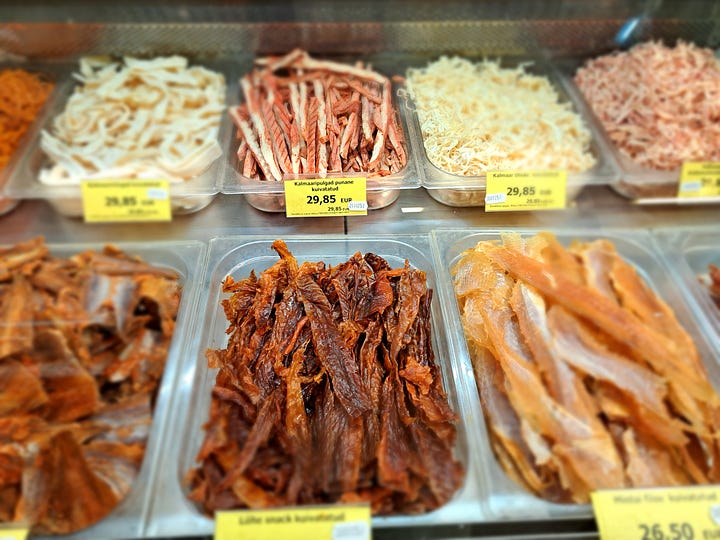
Fish. Fresh, smoked, cured, canned, dried. I wish I'd brought some back.
I returned to the market with my friends a few days later. Looking at the berries on one of the fruit stalls, one of my friends asked if the blueberries were local. The woman on the stall looked at her in surprise and snapped back, ‘ofcourse not, this is winter!’ You could almost hear her thinking, stupid tourist. Estonians know when their berries are in season.
What we ate in Tallinn


At the cute little cafe at the Kadrionu Kunstimuuseum; Pheasant pasty and pirogi.
Moose curry. How could I not? Estonians eat Estonian food at home, I was told. When they go out, they like to try food from other parts of the world. It was delicious in case you were wondering but in a blind tasting it's unlikely I'd know what I was eating.
At the BJT market; Pelmen Borscht, one of the best I’ve ever had. I’ve emailed them for the recipe. Ingredients on their website: pork, beef, potatoes, cabbage, onion, beetroot, head cabbage, tomato paste, garlic, vinegar, salt, pepper, sugar, dried plum, rapeseed oil
Farm; the most delicious salted white fish, white fish roe with sea buckthorn sauce. Isn't it pretty?
At Lore in the Noblessner area by the docks and Baltic sea we shared grass fed beef tartare, sesame seed cream, hazelnuts, Jerusalem artichoke and Asian style sauce; and Roasted salsify, burnt leeks, almond-olive oil cream and pickled caper leaves.
In the neighbourhood of Kalamaja, the wooden clap board houses used to be owned by fishermen. At a low key bakery that was more local community and after school hang out than hipster; Prinsesstårta cake. Semlor bun with cream and cloudberry jam.
At Cafe Maiasmokk, the ‘oldest continuously operating cafe in Tallinn, dating back to 1864.’ we fought a sea of tourists for a table. Lentil soup. Smoked sprat and egg pastry. There's a little shop and marzipan museum next door. Tallinn and Lubeck both claim to have invented marzipan. Marzipan animals, fruits and figures line the shelves; many of the moulds used are the originals. Visit the pharmacy in the town square; it’s the oldest continuously operating pharmacy of Europe dating to around 1422. They sell little bags of marzipan, originally given as a cure for broken hearts and stomach upsets.
Walking through the snow, we happened across Gelato Ladies. After a moment’s hesitation about eating ice cream when it’s -5, we went in. Semi sweet bun with sea buckthorn gelato and cream.
At Slavic restaurant Moon we shared pickled cucumbers with honey and sour cream, stump mushrooms marinated by granny´s recipe (what kind of mushroom is a stump? It’s the stump. You know, the stalk.) Borsch soup with beef, prunes, sour cream and greens, handmade pike fish dumplings in dill and beurre blanc sauce, roasted aubergine tartar with artichoke cream and sunchoke crisps, and hot buckwheat blinis with red onion, sour cream and whitefish roe.
Estonian 2022 Rabarbara sparkling rhubarb wine, Nudist is dry and delicious. We had to try the local liqueur, Vana Tallinn. We ordered one glass between us in case it was disgusting. It wasn’t. We ordered another. It’s rum based with citrus and cinnamon. Perfect for a chilly winter evening.
Last meal; we had a late evening flight. We skipped lunch in favour of a coffee and bun stop, and had a 4pm meal at Mix. You know the scenario. Finding a place that’s open at 4pm. Equidistant between the museum we’d be visiting and the hotel that was holding our luggage. Mix fitted the bill and their 3 course menu was E20. It's in a hotel but don't let that out you off. Incidentally, if you’re turfed out of your accommodation earlier than your flight, the hotel Viru has a left luggage facility and it's close to airport bus stops. It might have helped that we did their KGB museum tour. There's also a rather good lower ground supermarket in the shopping centre next door. We found Andre dairy cheese to bring back home.
What I'm going back for
I didn't get to Central Market (Keskturg) It's located south east of the old town. Founded in 1947, it's supposed to still have a Soviet era feel to it with a large meat hall, ‘‘where the largest and freshest selection of meat in the city is hidden. Endless fresh vegetables and berries. Fish of all sizes and unique handicrafts from us and elsewhere. Shopping with character guaranteed!’’
To Nomme for Nomme Market recommended as one of the city’s prettiest markets and for the walk through the Pääsküla bog
We didn’t get to the KGB prison cells because they’re closed on Mondays and Tuesdays.
Still to try;
Kali; fermented bread lemonade
Cheeses to look out for;
Kalamatsi Dairy Farm
Kolumatsi dairy
Andri-Peedo
Pirita promanade; for a walk by the Baltic sea from Birgitta Convent Ruins, to the memorial to the victims of communism and Tallinn Song Festival Grounds, home to the Estonian Song and Dance Celebration, which brings together up to 34,000 performers and 200,000 spectators every five years. And in Pirita, the Estonian History Museum.
I wasn't brave as my friend Tessa who went for a dip in the sea, and with our friend Una, to the sauna afterward but I might try a sauna next time.
A visit to Helsinki. The ferry from Tallinn to Helsinki takes just two hours.
Thank you local residents Brendan and Susanna, for your recommendations. And happy Independence Day Estonia.
Thank you for being here.
If you’d like to support me, do please think about a monthly or yearly subscription.
If it isn't possible please do consider
And do, if you like this piece, click on the heart which helps, really helps potential readers on Substack to find my work.
Thank you for reading.




















This was beautifully written! :) I will save this for my next trip to Tallin. I just started writing a series of Helsinki recommendations and your piece gave me inspiration for the next post.
Loved this post! I loved Tallinn when I visited, and now definitely want to go back! If just for Tallinn bun day!
Such a sad history, but I love that they freed themselves with music. Thank you for such a splendid post Cheryl